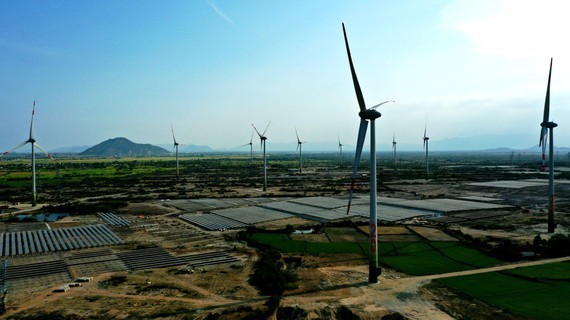
According to the updated report of the Science Council of Vietnam Energy Magazine, the power demand of the whole system in the next two years will be 15,400 megawatts (MWs). Meanwhile, in 2021, only about 3,600MWs of the capacity of three coal-fired power plants will be put into operation, namely Duyen Hai 2 BOT, Song Hau 1, and Hai Duong BOT. And by 2022, there will be Thai Binh 2, Nghi Son 2 BOT coal-fired power projects.
Thus, by the end of 2022, Vietnam will only add 6,000MWs from traditional sources of power, and there will be a shortage of more than 8,000MWs of capacity. By 2023, the traditional power sources will have only one more unit of the Van Phong 1 BOT Coal-Fired Thermal Power Plant with a capacity of 660MWs and the Nhon Trach 3 Gas Thermal Power Plant with a capacity of 880MWs. In total, in 2023, there will be 1,540MWs more, and more than 6,000MWs of power will remain insufficient.
From 2024 to 2025, according to the plan, many traditional power sources will be added, but the risks of delay are still evident. Therefore, the challenge is whether it is possible to strongly develop sources of RE with a capacity of more than 8,000MWs in the next two years.
Responding to this question, many experts affirmed that the sources of RE could meet a capacity of 8,000MWs within the next two years. In fact, within the past two years, after the Prime Minister decides the price support mechanism for RE, the sources of RE have grown rapidly, adding thousands of MWs to the national power system.
The latest information from Vietnam Electricity (EVN) shows that 113 solar and wind power projects with a total capacity of over 5,700 MWs have been released at full capacity and put into operation this year. This is a record number of new plants energizing in a short period.
The whole power system has mobilized 5.41 billion kWh from renewable energy, of which solar power reached 4.71 billion kWh, 5.35 times higher compared to the same period last year. Noticeably, if subtracting 1,000MWs of renewable energy by the end of last year, the country has 4,700MWs more in 2020. With the current growth rate, the sources of renewable energy can be supplemented to the system by more than 10,000MWs.
Especially, amid the current context, many private enterprises and people have continuously invested in solar power systems on the roofs of factories, farms, and townhouses. Similarly, for wind power, currently, there are active 16 projects with a total capacity of 642.6MWs. 13 wind power projects are under construction and expected to be put into operation in 2021, with a total capacity of 901MWs.
The rapid development of renewable energy has forced the Ministry of Industry and Trade (MoIT) to urgently revise the power plan. By the end of August this year, the total capacity of wind and solar power sources approved for the revised plan is nearly 23,000MWs. Of which, solar power is about 11,200 MWs, and wind power is about 11,800MW.
At the Vietnam Energy Forum 2020 that took place in mid-June this year, Deputy Minister of Industry and Trade Hoang Quoc Vuong (currently Chairman of Vietnam National Oil and Gas Group) said that the ministry would build transparent and competitive mechanisms to attract potential investors to develop RE projects.
Currently, the MoIT has been finalizing the draft National Power Development Master Plan for the period from 2021 to 2030, considering 2045 (a.k.a Power Development Master Plan 8) to submit it to the Prime Minister for approval. According to the scenarios in Power Development Master Plan 8, coal-fired power capacity will decrease by over 16.4 gigawatts (GWs), or 30 percent; hydropower capacity will reduce to 25 percent; gas power capacity will increase by nearly 7.8GWs or 42 percent; especially, wind power capacity will rise by 13GWs or three times higher, and solar power will surge by 6.2GWs, or 1.7 times higher. They are considered as good signs for a cleaner structure combination of power sources, significantly reducing gas emissions that cause environmental pollution.
Earlier, after balancing the long-term power supply, the MoIT sent a document to the Prime Minister, suggesting and proposing the Prime Minister to direct the People's Committees of provinces with hydropower projects and related agencies to not consider the proposals to supplement the planning for hydropower projects with a capacity less than 10MWs in the area.
For small hydropower projects in the planning but have not been constructed yet, they should be halted and only implement after the overall assessment results are released.
Currently, the MoIT continues to review hydropower projects that are already in the planning in the provincially-governed areas, evaluating in all aspects, such as legal compliance, environmental and social assurance, to complete the Power Development Master Plan 8.
Agreeing with the proposal of the MoIT, some experts said that it is necessary to stop building more hydroelectricity. Because the reservoirs water transfers of hydropower projects have negative impacts on the living environment of the people. Besides, the impacts of flood regulation, reservoirs can easily cause landslides, leading to serious consequences. Meanwhile, the investment in RE is more effective thanks to low costs and fewer impacts on the environment and society.
























